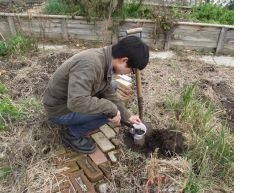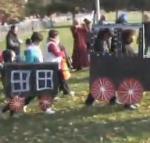
346 Lansdowne Avenue, Toronto
MacGregor Park
Part one B The Physical Garden
.

Site Inventory Checklist Page 10 of the C.G. Handbook. Choosing a site is very import and the first question the big question on everyone's mind these days: Is the soil safe? The whole soil question is a discussion in itself. ...
However - Now there is a new booklet released by Toronto Public Health GUIDE FOR SOIL TESTING IN URBAN GARDENS 2013 -
- Josephine Archbold: jarchbo@toronto.ca
.
Josephine Archibold is the contact person for more details and help. The point in this guide is for you to be equipped to make wise decisions for the future and health of the community garden. This guide is available as a resource, and Toronto Public Health is available to answer your questions. ... And there is a constant reminder: Actions are always recommended to reduce any health risks
The Guide for Soil Testing in Urban Gardens booklet is divided into three steps page 4
- Establish the level of concern
- Test the soil if necessary
- Take actions to reduce risks
.
Typically urban soils have higher levels of soil contaminants than rural soils Which poses the question where do urban soil contaminants come from?

- Urban mixed land uses primarily historical sources Such as:
- Industrial activities, past and present
- Ravine in-filling
- Dumping of waste (illegal and old landfills)
- Contaminants that come from our homes (old houses used lead paint)
- Transportation-sources (from a home - car oil change or a old car that was sitting there for a long time)
- Some soil qualities and problems are city-specific and specific within the city, even the site
.
.
You can establish the level of concern by doing a site visit and a site history check the book has broken it down into three levels of concern - From there you are lead to take one of three actions from - just good gardening practices, to doing soil samples or, building raised beds with new soil and compost.
.
Walk the Site page 7
The site visit involves walking through the area and inspecting the site thoroughly. Make a sketch of the area, look for signs of garbage or dumping, and speak with the folks in the neighbourhood. .
Searching the City Archives - page 9
The site History is done by reviewing your conversations with the people in the neighbourhood and searching the City Archives the booklet gives you the address, hours of operation, and the protocol of how to search for your land's history in the City Archives building. From this history you will have established the level of concern that you should have for your site page 25 and the action that it would involve:
- Low Concern - good gardening practices
- Medium Concern - doing soil samples - Page 14
- High Concern go straight to planning raised beds
.
You might be surprised that they don't recommend soil samples for the high concern that is because if there is enough visible evidence that the soil is contaminated the soil testing will only confirm it and you will still need to build those raised beds, so save the money and put it to better use.
Back to the land itself - To grow vegetables you need at least 6 - 8 hours of full sun. However, there is more to the land care - you still need to keep in mind the needs of your garden group. The accessibility needs, how much land you have and how many gardens and gardeners you would like to have. Depending on the leadership skills of your group and their needs you may wish to divide the land up into individual plots or just have several large communal plots. In my experience my community garden has several large 10' x 20' plots great for families. Some 10' x 10' plots ideal for single people, and several communal plots including one for the folks on the waiting list, so that they can get involved with the garden group and be able to plant a few things. BTW some community gardens have 10' x 5' plots In My Opinion that is just unsatisfying small!
.




 Show search options
Show search options




 You are on the [Part1B-ThePhysicalGarden-Aug2014] page of folder [Gardens]
You are on the [Part1B-ThePhysicalGarden-Aug2014] page of folder [Gardens] For the cover page of this folder go to the
For the cover page of this folder go to the